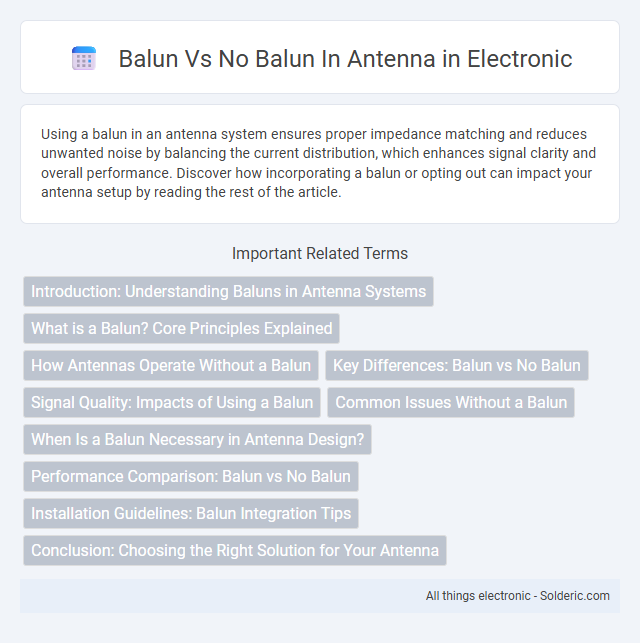Using a balun in an antenna system ensures proper impedance matching and reduces unwanted noise by balancing the current distribution, which enhances signal clarity and overall performance. Discover how incorporating a balun or opting out can impact your antenna setup by reading the rest of the article.
Comparison Table
| Feature | With Balun | Without Balun |
|---|---|---|
| Impedance Matching | Improves matching between antenna and feedline | Poor or inconsistent matching may occur |
| Signal Balance | Maintains balanced signal, reduces noise | Unbalanced signals can cause interference |
| Common Mode Currents | Suppresses common mode currents on feedline | Common mode currents can cause RF interference |
| Radiation Pattern | Preserves intended antenna radiation pattern | Distorted radiation pattern possible |
| Feedline Interference | Minimizes feedline radiation and interference | Increased feedline radiation and noise pickup |
| Installation Complexity | Requires additional component (balun) | Simpler setup without added parts |
Introduction: Understanding Baluns in Antenna Systems
Baluns, or balanced to unbalanced transformers, play a crucial role in antenna systems by matching impedance between components and reducing unwanted signal interference. Without a balun, your antenna may experience signal distortion, increased noise, and potential damage due to impedance mismatch. Using a balun ensures optimal performance and efficient signal transmission, enhancing overall antenna system reliability.
What is a Balun? Core Principles Explained
A balun (balanced to unbalanced) is an electrical device designed to convert between balanced and unbalanced signals, critical in antenna systems to ensure proper impedance matching and signal integrity. It minimizes interference caused by current imbalances on the feed line, reducing noise and improving overall antenna performance. Understanding how a balun functions helps optimize Your antenna setup by preventing signal distortion and enhancing transmission efficiency.
How Antennas Operate Without a Balun
Antennas operate without a balun by directly connecting the feedline to the antenna elements, which can cause unbalanced currents and increase radio frequency interference (RFI). Without a balun, your antenna system may experience impedance mismatches, resulting in reduced signal quality and potential radiation pattern distortion. Proper antenna design and placement can mitigate some issues encountered when operating without a balun, but overall antenna efficiency and performance often benefit from using a balun.
Key Differences: Balun vs No Balun
Baluns (balanced to unbalanced transformers) are crucial in antenna systems to effectively match impedance between balanced antennas and unbalanced coaxial cables, minimizing signal loss and reducing radio frequency interference. Without a balun, antennas may experience common-mode currents that cause signal distortion, increased noise, and potential feedline radiation. Your antenna setup benefits from a balun by ensuring optimal signal transfer, improved radiation patterns, and enhanced overall system performance.
Signal Quality: Impacts of Using a Balun
Using a balun in an antenna system significantly improves signal quality by minimizing common-mode currents and reducing electromagnetic interference. It ensures balanced impedance matching between the antenna and transmission line, resulting in clearer reception and transmission with less signal loss. Your setup benefits from enhanced signal stability and reduced noise when a balun is properly integrated.
Common Issues Without a Balun
Without a balun, antennas often experience common issues such as RF interference, increased signal noise, and unbalanced currents that cause distorted radiation patterns. Your antenna system risks higher levels of electromagnetic interference (EMI) and possible damage to connected equipment due to improper impedance matching and current imbalance. Using a balun effectively eliminates these problems by ensuring balanced signal transmission and reducing unwanted noise and signal loss.
When Is a Balun Necessary in Antenna Design?
A balun is necessary in antenna design when connecting a balanced antenna, such as a dipole, to an unbalanced transmission line, like coaxial cable, to prevent current imbalance and reduce signal distortion. Without a balun, common-mode currents can cause interference, radiation pattern distortion, and signal loss, affecting antenna performance. Baluns are crucial in maintaining impedance matching and minimizing electromagnetic interference in RF systems.
Performance Comparison: Balun vs No Balun
Using a balun in an antenna system significantly improves impedance matching and reduces common-mode currents, resulting in better signal integrity and reduced interference. Without a balun, antennas often experience RF current imbalances that degrade performance through increased noise and distorted radiation patterns. This leads to lower overall efficiency and compromised reception quality compared to setups employing baluns.
Installation Guidelines: Balun Integration Tips
Balun integration ensures balanced current distribution and minimizes signal interference, crucial for optimal antenna performance. When installing, connect the balun directly at the antenna feed point to maintain impedance matching and reduce common-mode currents. Your antenna system benefits from improved signal clarity and reduced noise by following precise mounting and grounding practices during balun installation.
Conclusion: Choosing the Right Solution for Your Antenna
Selecting between a balun and no balun for your antenna depends on impedance matching and signal integrity requirements. A balun effectively balances unbalanced feeds, reduces common-mode currents, and minimizes interference for improved reception quality. Without a balun, antennas may experience signal degradation and increased noise, making balun integration essential for optimal antenna performance in most applications.
balun vs no balun in antenna Infographic

 solderic.com
solderic.com